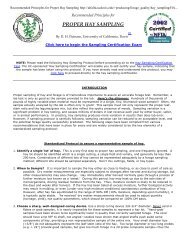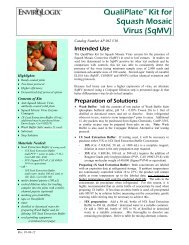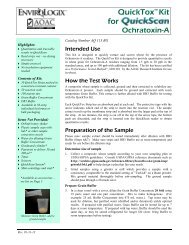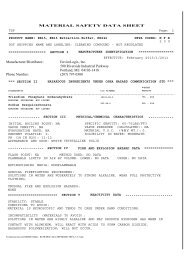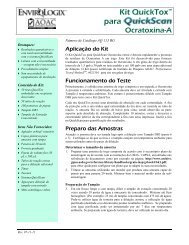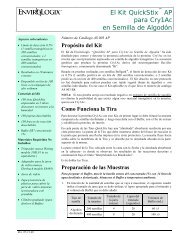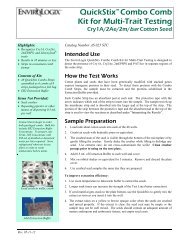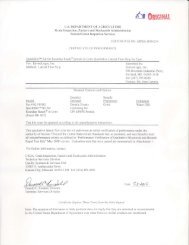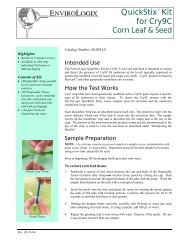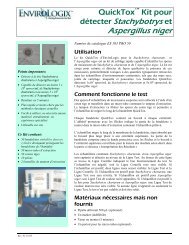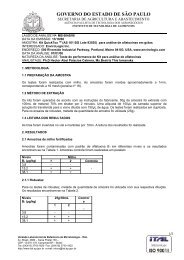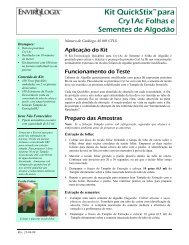1 TOXIC CYANOBACTERIA (BLUE-GREEN ALGAE ... - EnviroLogix
1 TOXIC CYANOBACTERIA (BLUE-GREEN ALGAE ... - EnviroLogix
1 TOXIC CYANOBACTERIA (BLUE-GREEN ALGAE ... - EnviroLogix
You also want an ePaper? Increase the reach of your titles
YUMPU automatically turns print PDFs into web optimized ePapers that Google loves.
<strong>TOXIC</strong> <strong>CYANOBACTERIA</strong> (<strong>BLUE</strong>-<strong>GREEN</strong> <strong>ALGAE</strong>):<br />
AN EMERGING CONCERN<br />
Robert C. Hoehn, Ph.D.<br />
Emeritus Professor<br />
The Charles E. Via, Jr. Department of Civil and Environmental Engineering<br />
Virginia Polytechnic Institute and State University<br />
Blacksburg, Virginia 24061<br />
INTRODUCTION<br />
Bruce W. Long, P.E.<br />
Vice President<br />
Director, Water Treatment Technology<br />
Black & Veatch<br />
Kansas City, Missouri 64114<br />
Cyanobacteria belong to a group of prokaryotic organisms identified by a variety of<br />
names, including cyanobacteria, blue-greens, blue-green algae, myxophyceans, cyanophytes,<br />
cyanophyceans, and cyanoprokaryotes. These primitive and highly adaptable organisms are<br />
most often referred to as either blue-green algae or cyanobacteria. Both terms are equally<br />
acceptable and can be used interchangeably. This group of organisms is unique among the<br />
bacteria in that they contain chlorophyll, and, therefore, are most likely the progenitors of<br />
true algae.<br />
Historically, water treatment personnel in the USA have regarded cyanobacteria only<br />
as nuisance organisms associated with earthy and musty tastes and odors and unsightly<br />
conditions in the water supply. The only drinking water regulation that currently applies to<br />
them in the USA is an unenforceable secondary maximum contaminant level (SMCL) for the<br />
threshold odor number (TON) of 3 (Federal Register, 1979). In other countries, however,<br />
toxin production by some cyanobacteria has long been recognized and is regarded as a<br />
serious issue.<br />
Carmichael (1992) attributed the apparent lack of concern in the USA to the fact that<br />
no link has ever been made between cyanobacterial toxins (cyanotoxins) in water supplies<br />
and human deaths or illnesses. Drinking water suppliers, regulators, and the public are<br />
generally unaware of potential problems that toxic cyanobacteria can cause, and neither the<br />
current nor pending regulations even mention them. The situation is changing, however. In<br />
1998, the United States Environmental Protection Agency (USEPA) included freshwater<br />
cyanobacteria and their toxins on the first Candidate Contaminant List (CCL) (Federal<br />
Register, 1998). This list includes organisms and chemicals selected on the basis of their<br />
potential public health significance and general unavailability of occurrence data and other<br />
relevant information. Cyanobacteria and their toxins were included in the CCL for two<br />
reasons, namely that (1) they are not necessarily associated with fecal contamination, and,<br />
1
therefore, will not be adequately controlled by provisions of either the Surface Water<br />
Treatment Rule or the Enhanced Surface Water Treatment Rule, and (2) they may not be<br />
adequately removed from drinking water by conventional water treatment techniques.<br />
Listing these organisms in the CCL, therefore, will focus attention on them and Amake them<br />
a priority for research to determine what triggers toxic algae growth in source water and the<br />
effectiveness of water treatment practices@ (Federal Register, 1998).<br />
Critical information regarding cyanobacteria and their toxins (e.g. occurrence,<br />
analytical methods, and health effects) must be available before the USEPA can begin to<br />
consider regulations for them. This information can be collected under the provisions of the<br />
1999 Unregulated Contaminants Monitoring Regulation (UCMR) discussed in Section 1412<br />
(1)(b)[b] of the 1996 Safe Drinking Water Act Amendments.<br />
In May, 2001, a panel of experts was convened by USEPA in Cincinnati to assist the<br />
agency in developing a target list of cyanotoxins and assigning priorities for future action.<br />
The Office of Drinking Water and Ground Water is currently reviewing the panel’s<br />
recommendations. Once the list is finalized, the prescreen portion of the UCMR will be used<br />
to develop occurrence data and evaluate analytical methods for the cyanobacteria and their<br />
toxins. Vulnerable water systems will be selected for monitoring, and analytical methods for<br />
toxin analyses will be developed and evaluated. In 2001, an entire session at the AWWA<br />
Water Quality Technology Conference (AWWA, 2001) was dedicated to papers by<br />
international experts in the area of cyanobacteria and their toxins.<br />
This paper discusses the following: (1) the biology of cyanobacteria, their association<br />
to “hazardous algal blooms (HABs)” in water supplies, the toxins that some species produce,<br />
and the methods for their detection and quantification, (2) available cyanobacterial bloomcontrol<br />
methods, (3) effectiveness of water treatment processes for cyanotoxin removal, (4)<br />
international guidelines for cyanotoxins in drinking water and the priorities the USEPA<br />
panel assigned to these toxins, and (5) the results of an recently completed assessment of<br />
cyanotoxins in North American drinking water supplies. Additional information regarding<br />
these and other cyanobacteria topics are available in a 1999 World Health Organization<br />
publication (Chorus and Bartram, 1999), and two American Water Works Association<br />
Research Foundation project reports (Yoo et al., 1995; and Carmichael, 2001).<br />
<strong>CYANOBACTERIA</strong>: ECOLOGY AND TOXIN PRODUCTION<br />
Ecology<br />
The dominant algal populations in temperate-zone surface waters change with the<br />
seasons. Diatoms and small flagellated algae typical dominate in winter and early spring<br />
followed by green algae in the late spring and early summer. In late summer and early fall,<br />
the dinoflagellates (pyrrophytes), large yellow-green algae (chrysophytes), and desmids are<br />
dominant. If the impoundments are eutrophic, the blue-green algae begin to emerge in the<br />
late summer when the water temperature increases and dominate the algal community until<br />
2
the water temperature decreases in the winter. Seasonal population differences are small in<br />
tropical lakes, and blue-green often are the dominant type most of the year.<br />
Cyanobacteria grow best in nonturbulent, warm rivers, lakes and reservoirs. Blooms<br />
usually occur during the warmest months of the year, especially when the water contains an<br />
over-abundance of nitrogen (N) and phosphorus (P). Excessive P most often provides the<br />
stimulus for cyanobacterial blooms, especially if the total N to total P concentration ratio is<br />
less than 10. Cyanobacteria with special structures called heterocysts can fix atmospheric<br />
nitrogen, and, in these species, nitrogen is seldom limiting. Carmichael (1994) described a<br />
bloom as an explosion of growth that occurs when light, temperature, and nutrients favor one<br />
species, resulting in cell densities of several million per liter.<br />
Another physiological feature that gives several cyanobacteria species a competitive<br />
edge in aquatic ecosystems is their ability to migrate vertically in the water column. Special<br />
gas-filled structures called “vesicles” are found within vacuoles inside the cells. Filling and<br />
emptying of these structures, along with the production and utilization of a high-molecularweight<br />
carbohydrate in the vacuoles, account for cell buoyancy. The accumulation of<br />
massive amounts of cell material on the surface is referred to as a “scum.”<br />
Dr. Justin Brookes (Australian Centre for Water Research, South Australia, personal<br />
communication, 2001) described the vertical migration process as follows:<br />
Vertical migration is often viewed as a mechanism to scavenge for the vertically<br />
separated resources, light and nutrients. The mechanism for buoyancy regulation<br />
and vertical migration is mostly due to the accumulation (and loss) of carbohydrate<br />
via photosynthesis (and respiration). The carbohydrate is actually the intermediates<br />
of photosynthesis (sugars) and has a density of about 1600 kg/m 3 . Consequently<br />
this acts as ballast and if sufficient is accumulated this may overcome the buoyancy<br />
provided by gas vesicles and the cell will tend to sink. Because photosynthesis is<br />
light dependent the accumulation of carbohydrate also changes in response to the<br />
light intensity.<br />
Cells in the early morning have low carbohydrate as they have been in the dark<br />
respiring carbohydrate - consequently they are buoyant. As solar insolation<br />
increases, the cells phostosynthesize, accumulate carbohydrate and tend to sink. As<br />
they migrate vertically they see less light and so the rate of carbohydrate<br />
accumulation decreases until the compensation irradiance where photosynthesis and<br />
respiration are equal. At lower light intensities respiration uses the carbohydrate<br />
and buoyancy is restored. In reality [vertical migration] is more complex than this<br />
and the short-term response to light is nested within a longer-term response to<br />
nutrients and light which affects gas vesicle volume etc.<br />
Toxin Production<br />
3
Toxic cyanobacteria are only one of several algae that cause what are referred to as<br />
“harmful algal blooms” (HABs), and they have been found on every continent except<br />
Antarctica. Other toxic algae include certain dinoflagellates (pyrrophytes) that cause the red<br />
tide, resulting in fish deaths and rendering inedible a variety of fish and shellfish. Only about<br />
2% of the many dinoflagellate species are toxic. Another toxic dinoflagellate, Pfiesteria<br />
piscicida (pronounced fee-STEER-ee-uh pis-kuh-SEED-uh), has wreaked havoc in estuaries<br />
from Delaware to North Carolina. The species name, piscicida, means “fish killer,” and its<br />
toxins cause fish lesions and death of aquatic organisms living in brackish and saline waters.<br />
Pfiesteria piscicida was first discovered in 1988 by N.C. State researchers. Unlike most of<br />
the dinoflagellate toxins, Pfiesteria toxins are extracellular and are used to stun fish. More<br />
information about these organisms can be found on the web at the following web sites:<br />
www.nal.usda.gov/wquic/pfiest.html and www.epa.gov/owow/estuaries/pfiesteria<br />
The term HAB has been used to describe toxic cyanobacterial blooms as well as red<br />
tide and Pfiesteria blooms. In 2000, public attention was focused on toxic cyanobacteria in<br />
Florida when blooms of Cylindrospermum raciborskii occurred in several lakes. In 1998,<br />
prior to the cyanobacterial blooms in water supplies, Florida established an HAB Task Force<br />
to address concerns over red tide and Pfiesteria blooms in costal waters, and this group<br />
became the major source of public information related to toxic cyanobacteria when the<br />
blooms occurred. A toll-free hotline for reporting possible illnesses caused by these<br />
organisms and a web site were established to provide operation and address public concerns.<br />
Numerous web sites on various aspects of cyanobacterial toxins are available.<br />
Toxic and nontoxic cyanobacteria are indistinguishable by microscopic examination,<br />
and both kinds may be in the same water bloom. Environmental conditions that foster toxin<br />
production are not well understood, and sophisticated tests are required for determining<br />
whether or not a bloom contains toxic species, and (Mur et al., 1999). The most common<br />
freshwater cyanotoxic genera are Anabaena, Aphanizomenon, and Microcystis bit others<br />
include Oscillatoria, Lyngbya, Planktothrix, Phormidium, and Anabaenopsis.<br />
Cylindrospermum raciborskii, which produces a hepatotoxic alkaloid, was the organism that<br />
was found in Florida lakes in 2000.<br />
HISTORICAL OVERVIEW OF CYANOTOXIN EPISODES<br />
Francis (1878) published the first report of deaths caused by toxic cyanobacteria, but<br />
animals, not humans, were involved. Numerous cattle, sheep, and horses died after they<br />
drank water from Lake Alexandrina near Adelaide, South Australia as it was experiencing a<br />
massive blue-green algal bloom. The agent was identified as Nodularia spumigena, which<br />
was later confirmed as the toxic agent by feeding it to a calf that subsequently died. Since<br />
then, numerous reports of animal and bird deaths have been published, but most events have<br />
been caused by toxins other than nodularin (Ressom et al., 1994; Kuiper-Goodman et al.,<br />
1999; WHO, 1999).<br />
4
Kuiper-Goodman et al. (1999) and Carmichael (1992) described several instances of<br />
cyanotoxin-related illnesses in humans dating back to 1931. Some of the events occurred<br />
after massive cyanobacterial blooms were treated with copper sulfate, which caused the cells<br />
to lyse and release the intracellular toxins. While toxins are released at all stages of their life,<br />
senescent cyanobacteria and those killed by copper sulfate liberate excessive quantities of<br />
toxins that can be difficult to remove by drinking water treatment.<br />
Poisonings are classified as either acute or chronic, but most human poisonings are<br />
chronic. The effects of acute poisonings occur very soon after exposure and include severe<br />
gastroenteritis, nausea, vomiting, diarrhea, and fever but rarely death (Carmichael, 1992).<br />
Numerous deaths did occur in Caruaru, Brazil, however, when 136 dialysis patients were<br />
exposed to microcystins in water used for the dialysis. Of these, 100 experienced liver<br />
failure, and 50 died (Kuiper-Goodman et al., 1999; Jochimsen et al., 1998). Potential chronic<br />
effects, which develop over a long period of exposure, include chronic liver damage and<br />
even carcinoma (Kuiper-Goodman et al., 1999). These are of greater concern because treated<br />
drinking water supplies would contain low levels of the toxins, not levels high enough to<br />
cause death. The possibility of liver cancer following exposure to cyanobacterial toxins is of<br />
special concern. Falconer (1983) monitored liver enzyme levels in a group of Australian<br />
men, women and children whose water supply was a reservoir that was plagued annually by<br />
cyanobacterial blooms. Following a massive Microcystis spp. bloom, elevated liver enzyme<br />
levels, which indicate liver damage, were found in many of the test subjects who drank<br />
treated water taken from the impacted reservoir. Yu (1989) studied the incidence of liver<br />
cancer in China and reported that the cancer rate was significantly higher among people who<br />
drank water from ditches containing massive blooms of cyanobacteria than in people in the<br />
same area who drank groundwater.<br />
Direct contact with cyanobacterial toxins in recreational lakes and reservoirs can also<br />
adversely affect humans by causing skin irritation and increasing the risk of gastrointestinal<br />
symptoms if the water is swallowed. Allergic responses to direct toxin exposure also can<br />
occur. Such incidents have been documented in Canada, the United Kingdom, and Australia<br />
(Kuiper-Goodman et al., 1999). Carmichael (2001) described numerous episodes of similar<br />
human poisonings brought about by direct contact with toxic cyanobacterial blooms in<br />
surface waters.<br />
CYANOTOXINS: CLASSIFICATION, EFFECTS, AND ANALYTICAL METHODS<br />
Classification and Effects<br />
Cyanotoxins can be classified according to the animal organs they affect and their<br />
according to their chemical structure. Neurotoxins affect the nervous system, hepatotoxins<br />
attack the liver, and dermatoxins irritate skin and mucous membranes. The three mostcommon<br />
cyanotoxins are described chemically as cyclic peptides, alkaloids, and<br />
lipopolysaccharides (LPS) ( Mur et al., 1999).<br />
5
Cyclic peptides. Most cyanobacterial poisonings are caused by a group of small-<br />
molecular-weight cyclic peptides known as microcystins and nodularins (Carmichael, 1997).<br />
These compounds are produced by certain species of Nostoc, Microcystis, Anabaenopsis,<br />
Anabaena, and Oscillatoria. Some Anabaena and Oscillatoria species also produce odorcausing<br />
compounds, but no statistical correlation has been found between toxin<br />
concentrations of the odor compounds in water supplies (Hrudey et al., 1993; Carmichael,<br />
2001). Carmichael (2001), however, found a high percentage of raw water supplies<br />
containing cyanotoxins during blue-green algal blooms also were experiencing taste-andodor<br />
problems at the time the waters were tested for toxins.<br />
Microcystins, which is the most common class of toxins worldwide, was first isolated<br />
from Microcystis aeruginosa, the organism from which their name is derived (Carmichael,<br />
1988). Other Microcystis species that produce these toxins are M. viridis and M.<br />
wesenbergii, but M. aeruginosa is the species most often identified with freshwater<br />
cyanobacterial poisonings (Carmichael, 2001). Approximately 65 structural variants of<br />
microcystin have been described (Mur et al. 1999). The most common is microcystin-LR,<br />
(“L” means leucine and “R” means arginine). Certain Anabaena and Oscillatoria species<br />
also produce microcystins. Carmichael (1992) described the symptoms of acute hepatotoxin<br />
poisonings in animals as whitening of the mucous membranes, vomiting, cold extremities,<br />
and diarrhea. Death occurs by hemorrhage within liver tissue. Acute poisonings are not<br />
expected in human populations except in rare cases where massive amounts of cellular<br />
material would be ingested. Chronic poisonings in humans are more likely and are indicated<br />
by gastrointestinal upsets, diarrhea, vomiting, and, in the worst case, liver cancer.<br />
Nodularins, the other cyclic peptide toxin group, are produced by only one<br />
cyanobacterial species, Nodularia spumigena, which is most found predominantly in the<br />
Baltic Sea and brackish estuaries and in costal lakes in New Zealand and Australia (Mur et<br />
al. 1999). The nodularins are generally unimportant in fresh waters.<br />
Alkaloid toxins. Both neurotoxic and cytotoxic alkaloids have been identified. The<br />
major neurotoxic alkaloids are the anatoxins and saxitoxins, and the major cytotoxic alkaloid<br />
is cylindrospermopsin. Only acute poisonings involving these toxins have been studied, and<br />
the effects of chronic exposures are not known.<br />
The anatoxins include anatoxin-a (the “fast-death factor”), anatoxin-a(S), and<br />
homoanatoxin-a. Each affects nerves and interferes with the smooth transition of stimuli to<br />
the muscles. Anatoxin-a has been isolated from species of Anabaena, Oscillatoria, and<br />
Aphanizomenon species. Anatoxin-a(S) (S means Asalivation factor@) occurs primarily in<br />
Anabaena species, including A. flos-aquae, A. spiroides, and A. circinalis (Carmichael,<br />
1992; 2001). Animals that ingest large quantities of cyanobacteria that produce these toxins<br />
die in a matter of seconds. Death is caused by paralysis of the respiratory muscles but is<br />
often preceded by leaping, staggering, muscle twitching, gasping, and convulsions.<br />
Anatoxin-a(S) causes profuse salivation in addition to the other manifestations of anatoxin-a<br />
poisoning. Large animals can be poisoned by drinking only a few liters of neurotoxincontaining<br />
water while small birds and mammals can be killed if they ingest only a few<br />
6
milliliters (Carmichael and Gorham, 1977; Carmichael et al., 1977; Carmichael and Biggs,<br />
1978).<br />
The neurotoxin saxitoxins are also known as Paralytic Shellfish Poisonings (PSPs)<br />
and include the both the saxitoxins and neosaxitoxin. Sixteen saxitoxins have been identified<br />
so far. (Carmichael, 2001). Dinoflagellates such as those that cause the red tide phenomenon<br />
and Pfiesteria piscicida are the best known producers of these toxins. As mentioned earlier,<br />
they pose no threat to human health through public water supplies. Some freshwater<br />
cyanobacteria - including Aphanizomenon flos-aquae, Anabaena circinalis, and Lyngbya<br />
wollei - also produce neurotoxic saxitoxins (Mur et al. 1999). Certain strains of<br />
Aphanizomenon flos-aquae, which thus far have been found only in New Hampshire,<br />
produce both saxitoxins and neosaxitoxin (Carmichael, 2001). Mur et al. (1999) mentioned<br />
that freshwater mats of PSP-producing Lyngbya wollei have been found in southern and<br />
south-central reservoirs and lakes in the USA. Saxitoxins and related neurotoxins produced<br />
by massive blooms of Anabaena spp. were responsible for the death of 1600 cattle and sheep<br />
along the Murray River in Australia in 1990 (Humpage et al. 1993).<br />
The cytotoxic alkaloid cylindrospermopsin affects mainly the liver and is found most<br />
often in blooms occurring in tropical, subtropical, and arid regions. It was identified afterthe-fact<br />
as the cause a 1979 poisoning, which at the time was referred to as ‘Palm Island<br />
mystery disease” because the cause of the problem was not readily identified in either foods<br />
or fecal samples from the affected populace. In all, 140 children and 10 adults were affected,<br />
and while none died, extensive therapy was required for most of them. An epidemiological<br />
study revealed that the drinking-water source used by all the victims was Solomon Dam,<br />
and individuals on other water supplies were unaffected. Prior to the outbreak, a bloom of<br />
Cylindrospermum raciborskii had been discovered in the dam reservoir and treated with<br />
copper sulfate. The algicide caused the cells to rupture releasing large quantities of<br />
cylindrospermopsin into the water (Bourke et al., 1983; Kuiper-Goodman et al., 2001). The<br />
affected children suffered symptoms of toxin exposure toxin that included “malaise,<br />
anorexia, vomiting, headache, painful liver enlargement, initial constipation followed by<br />
bloody diarrhoea and varying levels of severity of dehydration” (Kuiper-Goodman et al.,<br />
2001).<br />
Since the Palm Island episode, Cylindrospermum raciborskii has been isolated from<br />
other lakes in Australia and in Hungary. Cylindrospermopsin has been isolated from other<br />
cyanobacteria, including Umezakia nata in Japan and Aphanizomenon ovalisporum in Israel.<br />
Increasing numbers of occurrences of C. raciborskii blooms have been reported in Europe<br />
and Asia (Mur et al. 1999).<br />
Lipopolysaccharides (LPS). These toxins are in a class of toxins called<br />
“endotoxins” and are often referred to as “irritant toxins” (Sivonen & Jones, 1999). They are<br />
produced by cyanobacteria whose cell-wall constituents are similar to but less potent than<br />
the toxins found in Gram negative bacteria such as Salmonella. They were first isolated from<br />
cyanobacteria by Weise et al. (1970). The toxins can cause irritant and allergenic responses<br />
in humans who come in contact with them. The main effects are the result of direct contact<br />
7
ather than ingestion, but the health risks are not well understood at this time (Sivonen &<br />
Jones, 1999). They are of special interest in Australia but have not received much attention<br />
in the USA.<br />
Analytical Methods<br />
Methods for identification and screening are available (Yoo et al. 1995), but the<br />
identification methods (e.g. liquid chromatography followed by mass spectroscopy) require<br />
sophisticated instrumentation and analytical skills most likely unavailable only in<br />
commercial and research laboratories. Screening tests, which are simpler and most practical<br />
for consideration by water utilities, include: (1) enzyme-linked immunosorbent assays<br />
(ELISA) for which commercial kits are commercially available and which are the most<br />
ubiquitous (Carmichael 2001), and (2) protein phosphatase inhibition (PPI) assays for which<br />
commercial kits are potentially forthcoming. The ELISA kits can be used for quantification.<br />
Carmichael (2001) used a Apolyclonal MYCYST-LR antibody test kit, which is<br />
available from several commercial suppliers. Information from one supplier (<strong>EnviroLogix</strong><br />
Inc.; Portland, Maine) describes the test as being one in which Amicrocystin toxin competes<br />
with enzyme (horseradish peroxidase)-labeled microcystin for a limited number of antibody<br />
binding sites immobilized to the inside surface of the test wells.@ The microcystin<br />
concentration is related to the color intensity that develops on strips to which sample water<br />
and reagents have been added. The color is compared to a chart, and lighter colors indicate<br />
higher concentrations. The limit of detection (LOD) for four microcystins varies from 0.15<br />
µg/L to 0.44 µg/L.<br />
The ELISA kits, which at present are mainly for microcystins, are available from<br />
<strong>EnviroLogix</strong>, Inc. in Portland, Maine, and CyanoLab in Palatka, Florida. The contact at<br />
<strong>EnviroLogix</strong> at this writing is Mr. John Chamberlain at (207) 797-0300, extension 428, and<br />
the CyanoLab contact is Mr. John Burns, (366) 3280-9646. Each company has a web site.<br />
Mouse bioassays are also used for screening cyanotoxins in cells and water, but they<br />
are difficult, expensive, and impractical for consideration at all but the largest research<br />
laboratories. Detailed discussions of all the analytical and screening methods for cyanotoxins<br />
are available elsewhere (Yoo et al., 1995; WHO, 1999).<br />
USEPA Advisory Panel Toxin Prioritization for Future<br />
The advisory panel that USEPA convened in 2001 to advise the agency on matters<br />
related to cyanobacteria prioritized the cyanotoxins for future studies. The highest priorities<br />
were given to microcystins, cylindrospermopsin, and anatoxin-a. The saxitoxins and<br />
anatoxin-a(S) were assigned medium–to-high priority, while nodularin, lyngbyatoxin and a<br />
host of other less-commonly found toxins were listed as “needing additional study.” The<br />
LPS toxins were not assigned any priority because the panel felt they did not pose problems<br />
in US drinking water supplies.<br />
8
CYANOTOXIN HAZARDS, RISK ASSESSMENTS, AND GUIDELINES<br />
Hazards<br />
While direct evidence is lacking, some past public-health episodes may have been<br />
related to cyanobacteria in drinking water supplies. Tisdale (1931) published the earliest<br />
report of suspected cyanobacterial poisonings in the USA. Several thousand Charleston,<br />
West Virginia, residents who drank city water experienced acute gastroenteritis following<br />
massive cyanobacteria growths in the Kanawa River from which their water supply was<br />
derived. While the illnesses could not be directly linked to the cyanobacteria,<br />
epidemiological studies failed to find any enteric pathogens. Public health officials noted<br />
that the outbreak followed a heavy growth of algae associated with taste-and-odor problems<br />
in the water supply. In 1976, another outbreak of gastroenteritis occurred among 62% of the<br />
population over a 6-day period in Sewickley, Pennsylvania (Lippy and Erb, 1976). Similar<br />
episodes have been reported in Canada, Australia, the United Kingdom, and South Africa<br />
(Carmichael, 2001).<br />
Risk assessments<br />
Acute lethal injury caused by cyanotoxins in water is unlikely in the United States,<br />
and chronic exposure is potentially of greater concern. Carmichael (2001) pointed out (1)<br />
that risk assessments are possible only when the expected frequencies of undesirable effects<br />
brought about by exposure to a toxicant can be estimated and (2) that the term Ahazard@ is<br />
more appropriate when either quantification data or rates of toxic effects derived during<br />
actual studies are lacking. He further noted that most toxin exposures occur primarily in one<br />
of two ways: (1) direct contact with water containing the toxins and cyanobacteria or direct<br />
ingestion of water by swimmers and water skiers during recreational activities and (2) eating<br />
dietary supplements made with cyanobacteria. Some people are exposed during showering<br />
by inhalation of water droplets containing toxins, but Carmichael considered this exposure<br />
route to be minor.<br />
Tumor promotion by exposure to cyanobacterial toxins poses an added risk and must<br />
be factored into risk calculations along with data from animal studies and toxicological and<br />
chemical information. Few data are available regarding human exposure to cyanobacterial<br />
toxics through drinking water.<br />
Studies leading to the establishment of a drinking water standard for microcystins in<br />
terms of either a no-adverse-effect level (NOAEL) or maximum acceptable concentration<br />
(MAC) are being conducted by public health authorities in Australia, Canada, and Great<br />
Britain. Canadian authorities have proposed a MAC of 0.5 µg/L for m-LR. In the absence of<br />
Apotency equivalency values@ for other microcystins, Canadian authorities have proposed 1<br />
µg/L for total microcystins. Australian authorities, using toxicological results from pigfeeding<br />
studies (Falconer 1994) and incorporating a safety factor for tumor promotion,<br />
established a NOAEL for microcystins and nodularins at 1.0 µg/L (Carmichael, 2001)<br />
9
Falconer et al. (1999) described the method that is used in calculations of an exposure<br />
guideline for m-LR based on the tolerable daily intake (TDI), adult body weight, and the<br />
percentage of the TDI that occurs through a daily drinking water intake of 2 L/d. Based on<br />
available data, WHO published a provisional value of 1.0 µg/L (WHO, 1998; 1999). The<br />
authors noted that the guideline applied only to m-LR because data on which to base a<br />
guideline for all the cyanotoxins were unavailable.<br />
Guidelines<br />
At present, the USA has established no guidelines for any of the cyanotoxins.<br />
Germany and New Zealand have a microcystin guideline of 1.0 µg/L, which is the same as<br />
the WHO guideline (WHO, 1998, 1999). Canada’s total microcystin guideline is 1.5 µg/L,<br />
while Australia’s is1.3 µg/L in terms of m-LR toxicity equivalents. The United Kingdom’s<br />
position on guidelines is that the individual water utilities are bound by law to protect the<br />
consumers, so no need exists for the government to become involved. Australia has<br />
suggested 3 µg/L as potential guidelines for both anatoxin-a and the saxitoxins and is<br />
considering a cylindrospermopsin guideline in the range of 1-15 µg/L.<br />
MANAGING POTENTIAL RISKS WITH BLOOM CONTROL AND DRINKING<br />
WATER TREATMENT<br />
Human risks of cyanotoxin exposure through drinking water can be minimized by<br />
prevention of cyanobacterial blooms in waters supplies and removing the toxins during<br />
drinking water treatment.<br />
Bloom control<br />
The most effective weapon against the occurrence of cyanobacterial toxins in water<br />
supplies obviously is bloom prevention. Because inorganic nutrients (nitrogen and<br />
phosphorus) are usually responsible for blooms, good watershed management to prevent<br />
their influx to raw water supplies (Federal Register, 1998). However, eutrophic lakes and<br />
reservoirs that have been impacted by years of poor watershed management and excessive<br />
nutrient loadings improve slowly after best management practices are in place. Lake<br />
sediments usually are laden with phosphorus, and in deep lakes, the phosphorus can be<br />
released when the bottom becomes anaerobic during the summer. For this reason, much of<br />
the research into cyanobacterial toxin control has focused not on watershed management but<br />
rather on the effectiveness of various in-plant treatment processes for removing the toxins.<br />
Numerous cyanobacterial bloom-control measures have been summarized by Chorus<br />
and Luuc (1999) and by Yoo et al. (1995). As was mentioned earlier, toxic and nontoxic<br />
cyanobacterial species are indistinguishable by microscopic examination, so control of all<br />
blooms should be everyone’s goal. The potential for toxin production by the same organisms<br />
that cause taste-and-odor problems has raised the issue of cyanobacterial bloom control to a<br />
new level of importance.<br />
10
Many drinking water utilities apply copper sulfate and copper complexes (e.g. copper<br />
citrate, copper enolate) for bloom control in reservoirs and lakes. Care must be taken to treat<br />
the water supplies before a bloom is well established, however, because soluble<br />
cyanobacterial toxin concentrations, like those of the taste-and-odor compounds, increase<br />
substantially if the bloom is well developed. Bacterial degradation of the toxins in water<br />
supplies is usually slow process (Jones and Orr 1994). Intact cyanobacterial cells entering<br />
the treatment plant in large numbers may be removed by coagulation, flocculation,<br />
sedimentation and filtration but will lyse if oxidants are added first (Drikas et al., 2001a,<br />
2002b). The soluble toxins cannot be removed by physical methods.<br />
Water utilities that use rivers and large lakes as their raw water source usually cannot<br />
use copper-based algicides to control cyanobacterial blooms. Cyanobacterial control options<br />
in these cases are limited and usually are focused on controlling nutrient inputs from point<br />
discharges (notably secondary-treated wastewater discharges) and urban/agricultural runoff.<br />
When phosphorus is the growth-limiting nutrient, both external and internal (sediment)<br />
sources must be controlled. Internal nutrient cycling is usually prevented by in-lake<br />
treatments such as aeration.<br />
Drinking Water Treatment<br />
Hrudey et al. (1999), Yoo et al. (1995), and Drikas et al. (2001b) summarized<br />
effectiveness of water treatment processes for removing cyanobacterial cells and toxins from<br />
drinking water. All the evidence seems to suggest that activated carbon adsorption and<br />
oxidation are the most effective treatments for removing dissolved toxins, while routine<br />
coagulation, flocculation, and filtration and air flotation prior removes intact cells. The<br />
following summarize the available information.<br />
Conventional coagulation, flocculation, sedimentation. Drikas et al. (2001a,<br />
2001b) found that coagulation with iron salts and alum followed by conventional<br />
flocculation and sedimentation was effective for removing intact cyanobacterial cells from<br />
drinking water. However, they also found that rapid removal of sludge from basins was<br />
critical because the cells died in a short time, causing lysis and subsequent toxin release.<br />
Preoxidation should be discontinued if large numbers of cyanobacteria are entering the plant<br />
because the cells are killed, thus increasing the amount of toxin that has to be removed by<br />
other treatment procedures.<br />
Membranes. Utrafiltration (UF) and microfiltration (MF) membranes effectively<br />
removed intact cyanobacterial cells from water without significantly damaging them, but MF<br />
membranes were harder to clean. Some toxin adsorption on UF membranes was observed by<br />
Drikas et al. (2001b). Soluble toxins generally are not effectively removed by either UF or<br />
MF membranes, though Hart and Stott (1993) found that microcystin spiked into raw water<br />
at 5 µg/L and 30 µg/L was removed to concentrations less than 1 µg/L by nanofiltration.<br />
Other information regarding cyanotoxin removal by membranes was presented by Hrudey et<br />
al. (1999).<br />
11
Chlorination. Drikas et al. (2001b) found that chlorination was effective for<br />
destroying microcystin and cylindrospermopsin at pH < 8 if the dose was sufficient to<br />
provide a residual of 0.5 mg/L after 30-minutes contact. It was ineffective against anatoxina<br />
at pH 6-7. Chloramines were ineffective against any of the toxins because it they are not<br />
strong oxidants.<br />
Ozone. Ozone effectively inactivates microcystin and anatoxin-a at dosages high<br />
enough to kill Giardia and Cryptosporidium if a residual is found after 1 minute contact.<br />
Cylindrospermopsin is probably destroyed, but more work is need before more definitive<br />
statements can be made. Saxitoxins were not effectively oxidized to low levels. Ozone<br />
effects on the individual toxins are described below (Drikas et al. 2001b):<br />
Microcystins. Batch studies showed complete destruction of m-LR and m–LA in<br />
raw waters at O3 dosages great enough to produce a residual after 5 minutes contact.<br />
Dosages ranged from 0.2 mg/L to 1.8 mg/L O3. The dosages required to maintain a residual<br />
varied with the concentration of natural organic matter in the water supplies.<br />
Anatoxin-a. Patterns of O3 destruction of anatoxin-a were similar to those seen<br />
for the microcystin isomers. Higher initial O3 dosages were required, however, and raged<br />
from 0.5 to 2.5 mg/L.<br />
Saxitoxins. Six saxitoxins in a mixture were spiked into three Australia raw<br />
water samples and ozonated. Results indicated that the saxitoxins are not oxidized well by<br />
ozonation.<br />
Other oxidants. Drikas et al. (2001b) evaluated the effectiveness of hydrogen<br />
peroxide and potassium permanganate (KMnO4) in destroying m-LR. Hydrogen peroxide at<br />
a dose of 2 mg/L was ineffective, but 2 mg/L reduced the m-LR concentration by about 60%<br />
in 3 minutes and 95% in 10 minutes. In these studies, KmnO4 was more effective than<br />
chlorine (75% removal in 10 minutes with 2.0 mg/L) for destroying soluble m-LR but not for<br />
lysing cells.<br />
Chlorine dioxide (ClO2), even though it is a strong oxidant, is ineffective at dosages<br />
typically used during water treatment. Hart and Stott (1993), cited by Hrudey et al. (1999)<br />
found that 6 mg/L ClO2 reduced m-LR from 4.6 µg/L only to less than 1 µg/L, but a dose of<br />
10 µg/L had no effect on about 4 µg/L intracellular toxin.<br />
Powdered activated carbon (PAC). Most information about the effectiveness of<br />
PAC was derived from studies with m-LR, and, as is true in all studies involving activated<br />
carbon, the type of carbon and water-quality conditions were important variables.<br />
Microcystins. Drikas et al. (2001b) reported that mesoporous carbons (i.e. those<br />
with a high percentage of pores in the 2-50 nm range) were the most effective for removing<br />
m-LR, but large differences in efficiency were observed in the adsorption of four microcystin<br />
12
variants (5 µg/L concentration, 30 min contact) by two activated carbons (coal-based and<br />
wood-based). The order of effectiveness of both coal-based and wood-based carbon for<br />
adsorbing the four isomers was:<br />
m-RR > m-YR > m-LR > m-LA<br />
The coal-based PAC was more effective than the wood-based carbon in this study,<br />
but the authors stressed that different results can be expected with different carbons and rawwater<br />
quality conditions. The authors believed that m-LA could not be reliably removed by<br />
activated carbon adsorption.<br />
Anatoxin-a. While removal of this cyanotoxin has been studied to some extent,<br />
Drikas et al. (2001b) believed that the data were insufficient for making definitive<br />
statements. However, they stated that PAC likely<br />
Saxitoxins. Drikas et al. (2001b) found that the effectiveness of five PACs<br />
(carbon dosages 30 mg/L, 1 hour contact) for adsorbing saxitoxins in a mixture varying<br />
considerably and concluded that the relationship between molecular size of the toxins and<br />
the pore-volume distribution of the PAC was important.<br />
Cylindrospermopsin. Drikas et al. (2001b) stated that no information regarding<br />
PAC effectiveness for removing saxitoxins is available in the peer-reviewed international<br />
literature, but they cited results of three studies in other references, two in Australian<br />
conference proceedings and one conducted by an activated carbon manufacturer. In one<br />
study “good” removals were observed after 30 minutes contact with a wood-based PAC at<br />
dosages less than 30 mg/L. In another study, a maximum 60% removal was achieved with a<br />
variety of PACs at dosages of approximately 6 mg/L and 30 min. contact. In the third study,<br />
50% removal was achieved when by PAC at a concentration of only 2.7 mg/L; neither the<br />
PAC type nor contact time was mentioned.<br />
Granular activated carbon (GAC). Drikas et al. (2001b) reported the results of<br />
pilot-scale studies of GAC effectiveness for adsorbing cyanotoxins from water at two water<br />
treatment plant. The results are summarized below:<br />
Microcystins. Microcystin-LR and microcystin-LA (m-LA) were spiked into<br />
unchlorinated, treated water entering pilot GAC columns at two facilities. The first spike was<br />
added after 30 days operation. At one facility, both m-LR and m-LA were removed to levels<br />
below detection, but m-LA broke through at unacceptable levels at the second facility where<br />
the raw-water TOC was greater. Six months after startup, water entering the columns was<br />
again spiked with both isomers and opposite results were seen in that both m-LA and m-LR<br />
were removed to levels below detection at the second facility but broke through at the first.<br />
The explanation the authors gave was that microorganisms growing on the GAC at the first<br />
facility were unable to degrade either of the toxins but could degrade them at the second<br />
facility.<br />
13
Microcystin-LR biodegradation was rapidly degraded in a reservoir after a bloom of<br />
Microcystis aeruginosa had been killed by copper sulfate, but only after a lag period of three<br />
days (Jones and Orr, 1994). The authors suggested that the lag period was required for the<br />
development of a microcystin-degrading population of microbes in the reservoir.<br />
Drikas et al. (2001b) presented data that showing that a lag period of approximately<br />
16 days was required for the establishment of a microcystin-degrading microbial population<br />
in laboratory-scale GAC columns. The GAC was taken from one of the pilot plants that had<br />
been in use for three months. The influent was spiked with 20 µg/L of m-LR and m-LA.<br />
During the first 16 days of operation, removal of both isomers was obviously by adsorption,<br />
not biodegradation, but thereafter nearly 100% of both isomers was removed. After 68 days,<br />
the GAC was removed from the columns, sterilized, and placed back in service. The influent<br />
was then spiked with 30 µg/L of both isomers, and breakthrough to high levels was<br />
immediate.<br />
Anatoxin-a. Drikas et al. (2001b) cited the work of others wherein anatoxin-a<br />
adsorption data derived from small-scale GAC-column studies were used to predict removals<br />
by full-scale. . The investigators predicted that breakthrough would occur after about 15<br />
weeks of operation, but removal by bacterial activity on the columns was not considered.<br />
While acclimation and biological degradation are likely to occur, the authors could not<br />
recommend GAC for removal of anatoxin-a.<br />
Cylindrospermopsin. No data are presently available on which to base comments<br />
about GAC effectiveness for removing this cyanotoxin from water supplies.<br />
Saxitoxins. Drikas et al. (2001b) studied saxitoxin removals by a single GAC<br />
brand (ACI) over a six month period. The influent to the laboratory-scale GAC column was<br />
spiked with a mixture of six saxitoxins at the beginning of the study, again one month later,<br />
and again six months after the study began. After six months, removals in terms of<br />
“saxitoxin toxicity equivalents” was still satisfactory, about 70%. The authors recommended<br />
that microporous carbons (pores < 2 nm), such as those made from good grade coal and<br />
coconut shells, should be used to remove saxitoxins.<br />
Photolysis with ultraviolet light (UV). Drikas et al. (2001b) stated that conditions<br />
for toxin destruction by ultraviolet (UV) photolysis are likely to be outside the practical<br />
range for water treatment. They cited one study where irradiation of anatoxin-a at 254 nm<br />
was destroyed, but only at a dose twice that required for disinfection (about 30 mWs/cm 2 ).<br />
Hrudey et al. (1999), citing others, reported conflicting results regarding the<br />
effectiveness of UV for cyanotoxin destruction studies. Rositano and Nicholson (1994)<br />
reported that UV alone and UV with hydrogen peroxide reduced m-LR levels by about 50%<br />
after 30 minutes, but Croll and Hart (1996) found that UV efficiently degraded m-LR and<br />
anatoxin-a at UV dosages of about 20,000 mWs/cm 2 . Obviously, much more research is<br />
required before the true efficacy of UV irradiation for toxin destruction is known.<br />
14
AWWA RESEARCH FOUNDATION STUDY OF CYANOTOXINS IN UNITED<br />
STATES WATER SUPPLIES<br />
Carmichael (2001) analyzed cyanobacterial toxins in water samples submitted by<br />
utilities throughout the USA and Canada. Originally, 45 utilities agreed to submit samples<br />
over a two-year period at times when they were experiencing cyanobacterial blooms (i.e. ><br />
2,000 cells/mL) in their water supplies. Ten Acore utilities,@ collected samples twice a month<br />
for one year (December 1996 to December 1997). Participating utilities were selected on the<br />
basis of their geographic distribution within the USEPA regions; four Canadian utilities were<br />
included in the study as well.<br />
Samples collected by the utilities included: (1) surface/subsurface/bloom in the water<br />
supply (“plankton net tow” or grab sample), (2) inlet to the treatment system (intake), (3)<br />
treatment plant inlet (plant influent), and (4) the plant outlet (finished water). Aliquots of<br />
samples (1), (2), and (3) were filtered through glass-fiber filters, and then the water samples<br />
and glass-fiber filters were sent to Wayne State University for analysis. Some utilities sent<br />
samples to Metropolitan Water District of Southern California (MWDSC) for Flavor Profile<br />
Analysis (FPA) and GC/MS analyses of geosmin (earthy smell) and 2-methylisoborneol (2-<br />
MIB, musty smell). Each utility was asked to provide a map of their reservoir showing<br />
sampling locations.<br />
The project was completed in January, 1998, and 677 water samples and 458 filters had been<br />
analyzed for microcystins by ELISA and PPIA. A total microcystin concentration (ng/mL) was<br />
obtained by adding the concentrations of soluble microcystins in the filtrates and the concentrations<br />
extracted from cells retained on the filters. The results were as follows:<br />
! Total water samples: 677<br />
! Total filter-paper samples: 458<br />
! Total ELISA assays: 1135 at Wright State University, 1135 at the University of<br />
Wisconsin.<br />
! Total PPIA assays: 1135 at Wright State University and 275 at University of<br />
Wisconsin<br />
! Samples > 1 µg/L microcystins: -Source water: 12 (1.8%)<br />
-Intake water: 8 (1.2%)<br />
-Influent water: 7 (1.0%)<br />
-Finished water: 2 (0.3%)<br />
Microcystins were found in 80% of the 677 samples analyzed by ELISA, but only 4.3% of the<br />
samples contained levels that exceeded the WHO guideline (1 µg/L). Only two finished-water<br />
samples contained microcystins at levels greater than the 1 µg/L guideline.<br />
15
All the available data indicate that the treatment processes at the treatment plants during the<br />
period of this study effectively reduced microcystin concentrations to safe levels and that the<br />
majority of the water supplies with cyanobacteria did contain microcystins. Of the 243 samples<br />
evaluated for taste and odor, 75% were positive for either taste or odor by FPA or the presence of<br />
either geosmin or 2-MIB, and 82% of the 148 samples that were positive for taste or odor also<br />
contained microcystins. Carmichael recommended that utilities purchase commercially available<br />
kits for monitoring cyanotoxins in their water supplies.<br />
SUMMARY<br />
Toxic cyanobacteria (blue-green algae) are the latest in a series microbial organisms that can<br />
potentially pose some level of health risk in public water supplies. In the past, cyanobacteria have<br />
been regarded only as nuisance organisms that cause taste-and-odor problems in drinking water, but<br />
their potential for producing toxins with human health effects has been highlighted by their inclusion<br />
in USEPA’s 1998 Candidate Contaminant List, which specifies substances and microorganism in<br />
water that should be targeted for further investigation.<br />
The cyanotoxins of most concern in the United States are the hepatotoxins (primarily the<br />
microcystin isomers microcystin-LA and -LR) and the neurotoxins (mainly anatoxin-a and anatoxina(S)).<br />
Other neurotoxins include the saxitoxins, the best known of which cause red tide in costal<br />
waters, but even though they have been found in blooms of several Anabaena species, they are of<br />
less concern in the United States than anatoxin-a and the hepatotoxins. Blooms of Cylindrospermum<br />
raciborskii, which produce the cytotoxic (hepatoxic) alkaloid cylindrospermopsin, appeared recently<br />
in Florida, evoking considerable public interest but producing no health threat. Other individual<br />
species of Cylindrospermum have been shown to produce anatoxin-a. Cylindrospermopsin has also<br />
been given top priority for future study.<br />
Worldwide, the microcystins, which are produced primarily by Microcystis aeruginosa and<br />
certain Anabaena and Oscillatoria species, are likely to be present in eutrophic and hypereutrophic<br />
water supplies at concentrations sufficiently high to cause concern. These compounds have been<br />
shown to be liver tumor promoters, an issue that concerns public health officials in other countries.<br />
A special panel convened by the USEPA to advise the agency on cyanotoxin priorities for future<br />
study recommended that highest priority be assigned to the hepatotoxic microcystins, the cytotoxic<br />
alkaloid cylindrospermopsin, which also affects the liver, and the neurotoxic alkaloid anatoxin-a.<br />
Medium-to-high priority was assigned to the neurotoxic saxitoxins and anatoxin-a(s), some of which<br />
are produced by blue-green algae. The panel determined that the lipopolysaccharide toxins, which<br />
are skin- and mucous membrane irritants, are not enough of a problem in the United States to<br />
warrant concern at this time.<br />
The World Health Organization (WHO) has established a drinking water guideline of 1.0<br />
µg/L for m-LR, which is the most prevalent of the microcystins. Australia probably leads the world<br />
in cyanobacterial toxin research and in setting guidelines for many of the cyanotoxins, but no<br />
guideline has been established for any of the cyanotoxins in the United States.<br />
16
Microcystins-LR, which is the most-common cyanotoxin in blooms, can be removed<br />
effectively from drinking water by treatment with oxidation with ozone, chlorine, and permanganate<br />
and adsorption by both PAC and GAC. Neither UV irradiation, chlorine dioxide, nor chloramines<br />
are effective agents for destroying cyanotoxins. The effectiveness of PAC and GAC is water-quality<br />
specific, carbon specific, and toxin specific. For example, microcystin-LA, a less-common<br />
microcystin isomer, was not effectively removed by GAC in studies at the Australian Water<br />
Research Centre. Usually, carbons with a high percentage of large pores (2-50 nm) are best except<br />
for saxitoxins, which are better removed by microporous carbons.<br />
Care should be taken to minimize the entry of cyanobacterial cells into the treatment plant<br />
because they likely will be lysed during treatment and increase the levels of soluble toxins. Also, if<br />
copper sulfate is used to eliminate cyanobacteria in lakes and reservoirs, it should be applied before<br />
a bloom is established to avoid lysing the cells and subsequent high levels of soluble toxins in the<br />
influent to the water treatment plant. Carmichael=s AWWA Research Foundation project involving<br />
24 utilities in the United States and Canada demonstrated that water treatment plants in the United<br />
States and Canada are generally able to reduce microcystin levels to below the WHO guideline of 1<br />
µg/L.<br />
Easy-to-use kits for detecting microcystins in water supplies have been developed and are<br />
commercially available. Kits for other toxins are presently under development developed. Utilities<br />
experiencing problems with cyanobacteria each year should consider purchasing these reasonably<br />
inexpensive kits and monitor toxin levels in their raw and finished water during critical periods.<br />
REFERENCES<br />
American Water Works Association (AWWA), 2001. Proceedings Water Quality Technology Conf.,<br />
November 11-15, Nashville, TN, Denver, Colo. (CD format only).<br />
Bourke, A.T.C. et al., 1983. An Outbreak of Hepato-enteritis (the Palm Island Mystery Disease)<br />
Possibly Caused by Algal Intoxication. Toxicon, 3, Supplement, 45-48.<br />
Carmichael, W.W., 1992. A Status Report on Planktonic Cyanobacteria (Blue-Green Algae) and<br />
Their Toxins, EPA/600/R-92/079, Environmental Systems Laboratory, ORD, USEPA, Cincinnati,<br />
OH 45268, June, 1992, 141 pp.<br />
Carmichael, W.W., 1994. An Overview of Toxic Cyanobacterial Research in the United States. In:<br />
Proc. Of Toxic Cyanobacteria – A Global Perspective. Adelaide, South Australia: Australian Centre<br />
for Water Quality Research<br />
Carmichael, W.W., 1997. The Cyanotoxins. In: Advances in Botanical Research, Vol. 27. Edited by<br />
J. Callow. London. Academic Press.<br />
Carmichael, W.W., 2001. Assessment of Blue-Green Algal Toxins in Raw and Finished Drinking<br />
Water. AWWA Research Foundation, Denver, Colo. 179 pages.<br />
17
Carmichael, W.W. & D.F. Biggs, 1978. Muscle Sensitivity Differences in Two Avian Species to<br />
Anatoxin-a Produced by the Freshwater Cyanophyte Anabaena flos-aquae NRC-44-1.<br />
Canadian Jour. Zool. 56(3): 510-512.<br />
Carmichael, W.W. & P.R. Gorham, 1977. Factors Influencing the Toxicity and Animal<br />
Susceptibility of Anabaena flos-aquae (Cyanophyta) Blooms. Jour. Phycol. 13(97-101.<br />
Carmichael, W.W., P.R. Gorham, & D.F. Biggs, 1977. Two Laboratory Case Studies on the Oral<br />
Toxicity to Calves of the Freshwater Cyanophyte (Blue-green alga) Anabaena flos-aquae. Canadian<br />
Vet. Jour. 18:71-75.<br />
Carmichael, W.W. et al., 1988. Occurrence of the Toxic Cyanobacterium (blue-green alga)<br />
Microcystis aeruginosa in Central China. Archiv. Hydrobiol., 114:21-30.<br />
Chorus, I. & Mur, Luuc. 1999. Preventative Measures. Chapter 8, pp. 235-273. In: Toxic<br />
Cyanobacteria in Water: A Guide to Their Public Health Consequences, Monitoring, and<br />
Management. eds. Chorus, I. and Bartram, J. London and New York, E&FN Spon, 416 pp.<br />
Falconer, I.R., A.M. Beresford, and M.T.C. Runnegar. 1983. Evidence of Liver Damage by Toxin<br />
From a Bloom of the Blue-Green Algae, Microcystis aeruginosa. Medical Journal of Australia,<br />
1:511-514.<br />
Drikas, M. et al., 2001a. Using Coagulation, Flocculation, and Settling to Remove Toxic<br />
Cyanobacteria. Jour. AWWA. 93:2:100-111.<br />
Drikas, M. et al., 2001b. Water Treatment Options for Cyanobacteria and Their Toxins. Proceedings<br />
Water Quality Technology Conf. , November 11-15, Nashville, TN, Denver, Colo. (CD format only).<br />
Croll, B. & J. Hart. 1996. Algal Toxins and Customers. Paper presented at the UKWIR-AWWARF<br />
Technology Transfer Conference, Philadelphia.<br />
Drikas, M. et al., 2001b. Using Coagulation, Flocculation, and Settling to Remove Toxic<br />
Cyanobacteria, Jour. AWWA, 93:2:100-111.<br />
Falconer, I.R., A.M. Beresford, & M.T.C. Runnegar. 1983. Evidence of Liver Damage by Toxin<br />
From a Bloom of the Blue-Green Algae, Microcystis aeruginosa. Medical Journal of Australia,<br />
1:511-514.<br />
Falconer, I.R. et al., 1999. Safe Levels and Safe Practices. Chapter 5, pp. 155-178. In: Toxic<br />
Cyanobacteria in Water: A Guide to Their Public Health Consequences, Monitoring, and<br />
Management. eds. Chorus, I. and Bartram, J. London and New York. E&FN Spon, 416 pp.<br />
Federal Register.1998.Vol. 63, Number 40, Announcement of the Drinking Water Contaminant<br />
Candidate List, pp. 10273-10287, March 2.<br />
18
Federal Register.1979.Vol. 44, Number 140, Part 143 - National Secondary Drinking Water<br />
Regulations, pp. 42198-42202, July 19.<br />
Francis, G. 1878. Poisonous Australian Lake. Nature, 18: 11-12.<br />
Hart, J. & P. Stott. 1993. Microcystin-LR Removal from Water Report FR 0637, Foundation for<br />
Water Research, for Water Research, Marlow, UK.<br />
Hrudey, S. et al., 1999. Remedial Measures. Chapter 9, pp. 275-312. In: Toxic Cyanobacteria in<br />
Water: A Guide to Their Public Health Consequences, Monitoring, and Management. eds. Chorus, I.<br />
& J. Bartram, London and New York. E&FN Spon, 416 pp.<br />
Humpage, A.R. et al. 1993. Paralytic Shellfish Poisons from Freshwater Blue-Green Algae. Med.<br />
Jour. Australia (Letter), 159(6): 423.<br />
Jochimsen, E.M. et al. 1998. Liver Failure and Death Following Exposure to Microcystin Toxins at a<br />
Hemodialysis Center in Brazil. New England J. Med., 338(13)873-878.<br />
Jones, G. & P.T. Orr, 1994. Release and Degradation of Microcystin Following Algicide Treatment<br />
of a Microcystis aeruginosa Bloom in a Recreational Lake, as Determined by HPLC and Protein<br />
Phosphatase Inhibition Assay. Water Research, 28(4): 871-876.<br />
Kuiper-Goodman, T., I. Falconer, & J. Fitzgerald, 1999. Human Health Aspects. Chapter 4, pp. 112-<br />
153. In: Toxic Cyanobacteria in Water: A Guide to Their Public Health Consequences, Monitoring,<br />
and Management .eds. Chorus, I. and Bartram, J. London and New York. E&FN Spon, 416 pp.<br />
Lippy, E.C. & J. Erb, 1976. Gastrointestinal Illness at Sewickley, PA. Jour. AWWA, 68: 606-610.<br />
Mur, L.R., O.M. Skulberg, & H. Utkilen, 1999. Cyanobacteria in the Environment. Chapter 2, pp.<br />
15-40. In: Toxic Cyanobacteria in Water: A Guide to Their Public Health Consequences,<br />
Monitoring, and Management. eds. Chorus, I. and Bartram, J. London and New York. E&FN Spon,<br />
416 pp.<br />
Rositano, J. & B.C. Nicholson. 1994. Water Treatment Techniques for Removal of Cyanobacterial<br />
Toxins from Water. Bull. Bureau Plant. Indus. USDA, 76:19-55.<br />
Ressom, R. et al., 1994. Health Effects of Toxin Cyanobacteria (Blue-Green Algae). Australian<br />
National Health and Medical Research Council, Looking Glass Press, 108 pp.<br />
Sivonen, K. & G. Jones, 1999. Cyanobacterial Toxins. Chapter 3, pp 41-111. In: Toxic<br />
Cyanobacteria in Water: A Guide to Their Public Health Consequences, Monitoring, and<br />
Management. eds. Chorus, I. and Bartram, J. London and New York. E&FN Spon, 416 pp.<br />
Tisdale, E., 1931. Epidemic of Intestinal Disorders in Charleston, WVa, Occurring Simultaneously<br />
With Unprecedented Water Supply Conditions, American Journal of Public Health, 21:198-200.<br />
19
Weise, G. et al., 1970. Identification and analysis of lipopolysaccharide in cell walls of the bluegreen<br />
algae Anacystis nidulans, Arch. Microbiol., 71:, 81-89.<br />
World Health Organization (WHO). 1998. Guidelines for Drinking-water Quality. 2 nd edition,<br />
Addendum to Vol. 2. Health Criteria and Other Supporting Information. World Health<br />
Organization, Geneva.<br />
World Health Organization (WHO), 1999. Toxic Cyanobacteria in Water. Eds. I. Chorus and J.<br />
Bartram. E & FN Spon, an imprint of Toutledge, London. 416 pp.<br />
Yoo, R.S., W.W. Carmichael, R.C. Hoehn, S.E. Hrudey, 1995. Cyanobacterial (Blue-Green Algal)<br />
Toxins: A Resource Guide. AWWA Research Foundation & AWWA, Denver, 229 pp.<br />
Yu, S. –Z, 1989. Drinking Water and Primary Liver Cancer. In: Primary Liver Cancer, Z.Y. Tang,<br />
M.C. We, & S.S. Xia, eds., China Academic Publishers, New York, 30-37.<br />
20



